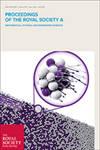Wetting and bonding characteristics of selected liquid metals with a high–power diode–laser–treated alumina bioceramic
Proceedings of the Royal Society of London. Series A. Mathematical and Physical Sciences
Pub Date : 2004-06-08
DOI:10.1098/rspa.2003.1228
引用次数: 7
Abstract
Changes in the wettability characteristics of an alumina bioceramic occasioned by high–power diode–laser (HPDL) surface treatment were apparent from the observed reduction in the contact angle. Such changes were due to the HPDL bringing about reductions in the surface roughness, increases in the surface O2 content and increases in the polar component of the surface energy. Additionally, HPDL treatment of the alumina–bioceramic surface was found to effect an improvement in the bonding characteristics by increasing the work of adhesion. An electronic approach was used to elucidate the bonding characteristics of the alumina bioceramic before and after HPDL treatment. It is postulated that HPDL–induced changes to the alumina bioceramic produced a surface with a reduced band–gap energy, which consequently increased the work of adhesion by increasing the electron transfer at the metal–oxide interface and thus the metal–oxide interactions. Furthermore, it is suggested that the increase in the work of adhesion of the alumina bioceramic after HPDL treatment was due to a correlation existing between the wettability and ionicity of the alumina bioceramic, for it is believed that the HPDL–treated surface is less ionic in nature than the untreated surface and therefore exhibits better wettability characteristics.选定液态金属与高功率二极管激光处理的氧化铝生物陶瓷的润湿和键合特性
高功率二极管激光(HPDL)表面处理引起的氧化铝生物陶瓷润湿性特性的变化从观察到的接触角的减小是明显的。这种变化是由于HPDL降低了表面粗糙度,增加了表面O2含量,增加了表面能的极性成分。此外,HPDL处理的铝-生物陶瓷表面被发现,通过增加附着力的影响,在键合特性的改善。采用电子方法研究了HPDL处理前后氧化铝生物陶瓷的成键特性。假设hpdl诱导的氧化铝生物陶瓷的变化产生了带隙能量降低的表面,从而通过增加金属-氧化物界面上的电子转移从而增加了粘附功,从而增加了金属-氧化物相互作用。此外,我们认为HPDL处理后的氧化铝生物陶瓷的附着力增加是由于氧化铝生物陶瓷的润湿性和离子性之间存在相关性,因为我们认为HPDL处理后的表面比未处理的表面具有更少的离子性质,因此表现出更好的润湿性特性。
本文章由计算机程序翻译,如有差异,请以英文原文为准。
求助全文
约1分钟内获得全文
求助全文
来源期刊
自引率
0.00%
发文量
0
期刊介绍:
Proceedings A publishes articles across the chemical, computational, Earth, engineering, mathematical, and physical sciences. The articles published are high-quality, original, fundamental articles of interest to a wide range of scientists, and often have long citation half-lives. As well as established disciplines, we encourage emerging and interdisciplinary areas.

 求助内容:
求助内容: 应助结果提醒方式:
应助结果提醒方式:


